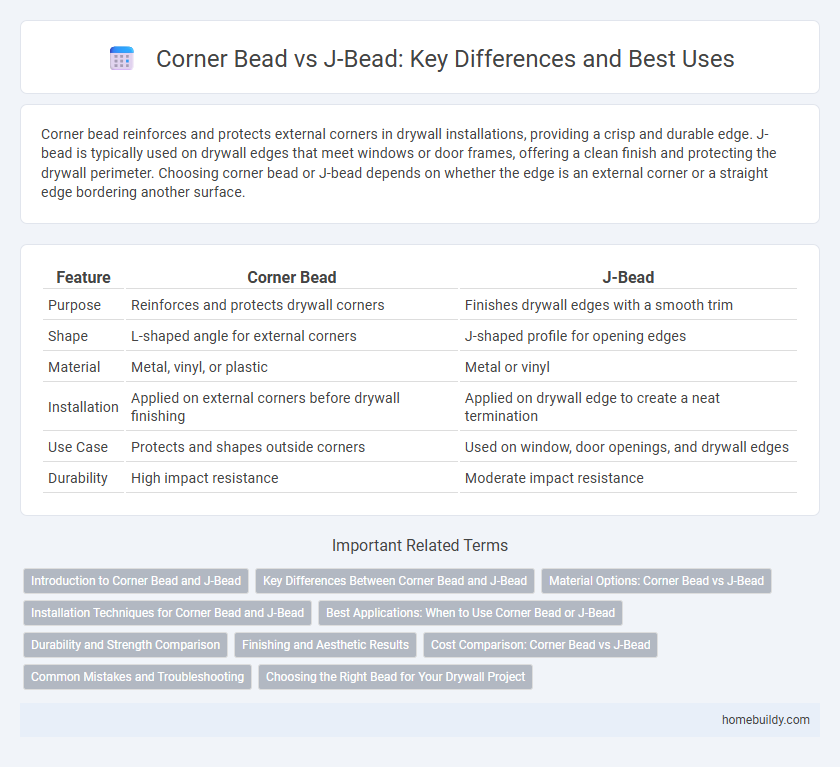Corner bead reinforces and protects external corners in drywall installations, providing a crisp and durable edge. J-bead is typically used on drywall edges that meet windows or door frames, offering a clean finish and protecting the drywall perimeter. Choosing corner bead or J-bead depends on whether the edge is an external corner or a straight edge bordering another surface.
Table of Comparison
| Feature | Corner Bead | J-Bead |
|---|---|---|
| Purpose | Reinforces and protects drywall corners | Finishes drywall edges with a smooth trim |
| Shape | L-shaped angle for external corners | J-shaped profile for opening edges |
| Material | Metal, vinyl, or plastic | Metal or vinyl |
| Installation | Applied on external corners before drywall finishing | Applied on drywall edge to create a neat termination |
| Use Case | Protects and shapes outside corners | Used on window, door openings, and drywall edges |
| Durability | High impact resistance | Moderate impact resistance |
Introduction to Corner Bead and J-Bead
Corner bead is a drywall accessory designed to protect and reinforce outside corners, ensuring a straight edge and preventing damage. J-bead, often used for finishing drywall edges, provides a clean, smooth transition between drywall and adjoining surfaces, especially for door and window openings. Both components are essential in drywall installation, with corner bead emphasizing corner durability and J-bead focusing on edge finishing.
Key Differences Between Corner Bead and J-Bead
Corner bead and J-bead serve distinct purposes in drywall finishing; corner bead is designed to reinforce and protect external drywall corners, providing a clean, sharp edge, while J-bead is used to finish drywall edges where the drywall terminates against a window, door frame, or other surface. Corner bead is typically made from metal or PVC and features an L-shaped profile that wraps around corners, whereas J-bead has a J-shaped profile that accepts drywall edges for smoother transitions. The choice between corner bead and J-bead depends on the drywall application, with corner bead enhancing corner durability and J-bead ensuring neat terminations.
Material Options: Corner Bead vs J-Bead
Corner beads are typically made from materials such as metal, vinyl, and paper-faced options, providing durability and resistance against impacts for wall corners. J-beads, commonly constructed from vinyl or metal, offer a clean edge finish for drywall termination points and are designed for flexibility in various applications. Choosing between corner bead and J-bead depends on the specific material properties needed, such as rigidity for corners or smooth edge transitions.
Installation Techniques for Corner Bead and J-Bead
Corner bead installation requires precise alignment and secure fastening at drywall corners to ensure a smooth, durable edge, often using nails, screws, or adhesive. J-bead installation focuses on creating clean, finished edges on drywall around openings by embedding the bead into the joint compound with consistent pressure. Both techniques demand careful measurement and drywall compound application to achieve professional, seamless results.
Best Applications: When to Use Corner Bead or J-Bead
Corner bead is ideal for reinforcing and protecting external drywall corners, providing a crisp, durable edge suited for high-traffic areas or locations prone to impact. J-bead is best used to finish drywall edges that meet window and door frames, metal studs, or other surfaces where a clean, precise edge is required without the need for corner reinforcement. Selecting corner bead or J-bead depends on whether the application involves an external corner needing extra durability or a perimeter edge requiring neat termination and aesthetic finish.
Durability and Strength Comparison
Corner bead offers superior durability and impact resistance compared to J-bead, making it ideal for high-traffic areas and exterior corners subject to frequent stress. Constructed from materials like galvanized steel or PVC, corner beads provide reinforced edges that prevent chipping and cracking over time. J-beads, while useful for finishing drywall edges, lack the robust structural support found in corner beads, resulting in reduced long-term strength and vulnerability to damage.
Finishing and Aesthetic Results
Corner bead provides a sharp, clean edge ideal for drywall corners, ensuring smooth finishes that enhance architectural lines. J-bead, designed for drywall edges exposed to open spaces, offers a rounded profile that softens transitions and prevents chipping. Choosing corner bead versus J-bead directly influences the final visual appeal and durability of drywall installations.
Cost Comparison: Corner Bead vs J-Bead
Corner bead generally costs less than J-bead due to its simpler design and widespread availability in standard sizes. J-bead, designed for edging drywall with a finished look, often incurs higher material and installation expenses, especially for custom lengths or finishes. Contractors often choose corner bead for budget-sensitive projects aiming for durability, while J-bead suits applications where aesthetic edge detail justifies the additional cost.
Common Mistakes and Troubleshooting
Common mistakes when installing corner bead versus J-bead include improper alignment and incorrect fastening, leading to uneven corners and compromised drywall edges. Troubleshooting often involves inspecting for gaps, ensuring the bead is flush with the drywall surface, and addressing tool marks or bulges by sanding and applying joint compound. Choosing the correct bead type based on corner shape and ensuring consistent fastening methods prevents cracking and improves overall durability.
Choosing the Right Bead for Your Drywall Project
Corner bead offers superior protection and durability for external drywall corners by reinforcing edges against impacts and wear, making it ideal for high-traffic areas. J-bead, designed to finish drywall edges where the drywall meets other surfaces, provides a clean, professional look but lacks the same level of corner reinforcement. Selecting the right bead depends on whether the project requires robust corner protection or a smooth edge finish, ensuring optimal structural integrity and aesthetic appeal.
corner bead vs J-bead Infographic

 homebuildy.com
homebuildy.com